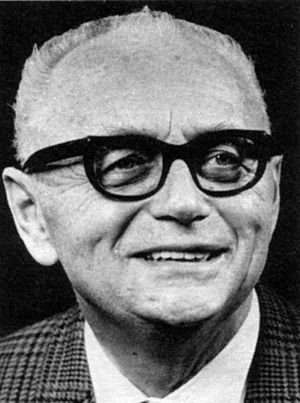Heinz Schlicke facts for kids
Quick facts for kids
Dr. Heinz Max Schlicke
|
|
|---|---|
 |
|
| Born | December 13, 1912 |
| Died | April 18, 2006 (aged 93) |
| Alma mater | Dresden University of Technology |
| Occupation | Engineer and Author |
| Employer | Allen-Bradley (1950-1974) |
| Known for | IEEE Fellow (1967) |
Heinz Schlicke (born December 13, 1912 – died April 18, 2006) was a smart engineer and author from Germany. He was one of the scientists who came to the United States after World War II as part of a special program called Operation Paperclip. He worked for many years at the Allen-Bradley Company.
Contents
The Engineering Journey of Heinz Schlicke
Early Life and Studies in Germany
Heinz Schlicke was born near Dresden, Germany, in 1912. He was very interested in engineering from a young age. He studied hard and earned both his master's and doctor's degrees. He completed his studies in engineering sciences in 1937. This was at the Institute of Technology in Dresden. His main teacher was Dr. Heinrich Barkhausen. For his final project, he studied how electronic signals can affect each other.
World War II and a Secret Mission
During World War II, Heinz Schlicke served in the German navy, known as the Kriegsmarine. He started as a Naval Engineer and worked his way up. He became a Lieutenant-Commander. Near the end of the war, he went on a very important secret mission. He was supposed to take special high-tech information and supplies to Japan. He traveled on a submarine called U-234.
The war with Germany ended on May 8, 1945. A few days later, on May 14, the U-234 surrendered to the United States. Schlicke was taken to a secret prisoner of war (POW) camp. This camp was called P. O. Box 1142 and was located in Fort Hunt, Virginia. In 1946, he was sent back to Germany.
Working in America
After a short time in Germany, Heinz Schlicke was invited to return to the United States. This was part of a special program called Operation Paperclip. This program brought talented German scientists to America. He worked for the Office of Naval Research in Sands Point, New York. There, he worked on what we now call stealth technology. This technology helps make objects like planes harder to detect.
In September 1950, he started a new job. He joined the Allen-Bradley Company in Milwaukee, Wisconsin. He was in charge of developing electronic parts made from a material called ferrite. Ferrites are special magnetic materials.
Later Career and Books
While working at Allen-Bradley, Heinz Schlicke wrote a book in 1961. It was called Essentials of Dielectromagnetic Engineering. This book explained how ferrites and other materials called dielectrics work. Dielectrics are materials that do not conduct electricity well.
In the late 1960s and early 1970s, he became very involved with Electromagnetic compatibility (EMC). EMC is about making sure electronic devices work well together. It prevents them from interfering with each other. He became the president of the IEEE Electromagnetic Compatibility Society. In 1967, he was recognized as an IEEE Fellow. This is a very high honor for engineers.
He retired from Allen-Bradley in 1974. However, he kept working as a consultant in the EMC field. He also wrote another book in 1982 called Electromagnetic Compossibility. In 1994, he wrote a book with his son, Lutz Schlicke. This book was about improving yourself and was titled Ready for any Challenge. Dr. Schlicke passed away peacefully in 2006 when he was 93 years old.

